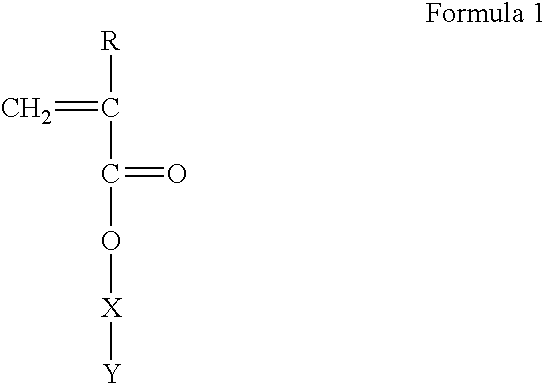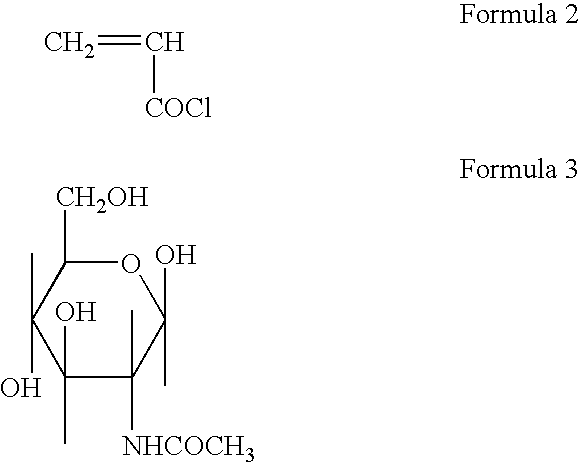Polymerizable monomers and process of preparation thereof
a polymerizable monomer and polymerizable technology, applied in the field of polymerizable monomers, can solve the problems of limited protein conjugation, unsuitable biologically active molecules, and high temperature that is not well tolerated by most of the proteins, and achieves enhanced binding, enhanced hydrolytic stability and water solubility, and effective inhibition
- Summary
- Abstract
- Description
- Claims
- Application Information
AI Technical Summary
Benefits of technology
Problems solved by technology
Method used
Image
Examples
example 2
[0068] Preparation of Methacryloyl 6-Amino Caproic Acid (M Ac. 6-ACA)
[0069] 250 ml capacity beaker was equipped with dropping funnel and pH meter. 13.16 gm 6ACA, 4 gm. sodium hydroxide and 80 ml. water was stirred continuously at 5 0 C on a magnetic stirrer. Nine milliliter of Methacryloyl Chloride in 10 ml dichlorQmeJhane was added drop wise to the above solution The pH of reaction mixture was maintained at 7.5 by the addition of 10M NaOH solution. Unreacted acid chloride was extracted in 100 ml ethyl acetate The clear aqueous solution was acidified to pH 5.0 using concentrated HCl and the product was extracted in ethyl acetate (3.times.100 ml). The organic layer was dried on anhydrous sodium sulfate and concentrated under vacuum. The viscous liquid was added to 500 ml petroleum ether. The solid product was obtained and vacuum dried for 48 hrs.
example 3
[0070] Preparation of Acryloyl 6-Amino Caproic Acid N-Acetyl Glucosamine (Ac. 6ACA NAG)
[0071] 5 gm of Acryloyl 6-Amino Caproic Acid (Ac. 6 ACA) and 5 97 gm. N-Acetyl lucosamine was dissolved in 20 ml dry Di Methyl Formamide (DMF). Clear solution was obtained by continuous stirring and 5.57 gm of Di Cyclohexyl Carbodiimide (DCC) as the coupling reagent was added. The reaction mixture was stirred continuously for 24 hrs. at room temperature. Di Cyclohexyl Urea (DCU) was filtered off and the monomer containing spacer and ligand NAG was precipitated in distilled acetone. It was vacuum dried for 48 hrs.
example 4
[0072] Estimation of binding constant (K.sub.b) of monomers containing NAG by fluorescence spectrophotometric method and the enhancement resulting from conjugation with monomers and monomer containing spacer.
[0073] Fluorescence spectra of lysozyme were recorded on a Perkin Elmer LS-50 B luminescence spectrophotometer. Excitation frequency was 285 nm, Solutions of lysozyme and N-Acetyl Glucosamine were prepared in 0.066 M phosphate buffer pH 6.2, containing 0.0154 M sodium chloride and 0.008 M sodium azide. 0 1 milliliter of lysozyme 80 .mu.g / ml was mixed with solution containing different ligand concentration in a 2 ml capacity 10 mm square quartz cells maintained at 18 0 C.
[0074] Phosphate buffer was added to make the volume to 2 ml. The fluorescence intensities of the solutions were measured, relative to the solutions containing enzymes and buffer mixtures of the identical concentrations reference. The relative fluorescence intensity of lysozyme saturated with solution containing ...
PUM
| Property | Measurement | Unit |
|---|---|---|
| Fraction | aaaaa | aaaaa |
| Angle | aaaaa | aaaaa |
| Fraction | aaaaa | aaaaa |
Abstract
Description
Claims
Application Information
 Login to View More
Login to View More - R&D
- Intellectual Property
- Life Sciences
- Materials
- Tech Scout
- Unparalleled Data Quality
- Higher Quality Content
- 60% Fewer Hallucinations
Browse by: Latest US Patents, China's latest patents, Technical Efficacy Thesaurus, Application Domain, Technology Topic, Popular Technical Reports.
© 2025 PatSnap. All rights reserved.Legal|Privacy policy|Modern Slavery Act Transparency Statement|Sitemap|About US| Contact US: help@patsnap.com



